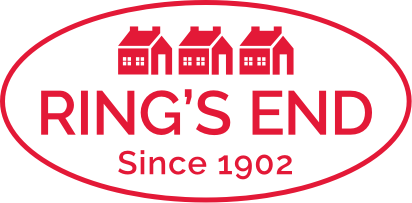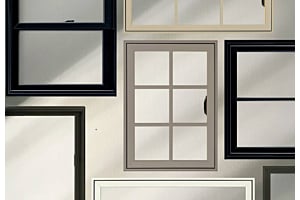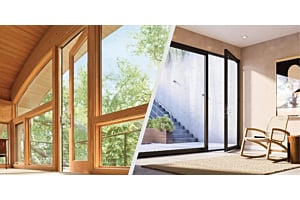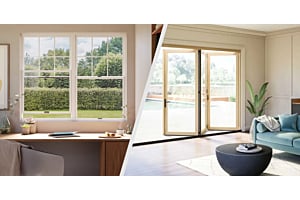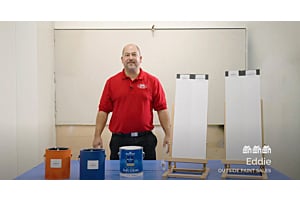
You’ve probably talked to one person who’s all Ben Moore and another who swears by Sherwin-Williams. But paint formulas change along with prices, and painters may find themselves needing to consider different options.
Here at Ring’s End, it’s important to us that our customers have access to the best building supplies, and that’s why we carry Benjamin Moore. When our paint pros evaluate Benjamin Moore vs Sherwin-Williams, Benjamin Moore outperforms the competition across the board.

Let’s take a closer look at how these paints are made, what they offer in color and coverage, and how they perform to better understand specific differences between the two paint brands.
Volume Solids: What They Are and Why They Matter
“Volume solids” refer to the part of the paint that stays behind after it dries—the pigments and binders that give paint its color and protective finish. The rest (mostly water or solvent) just evaporates.
The higher the percentage of volume solids, the more paint you’re leaving on the wall with each coat. That means better coverage, richer color, and a more durable surface overall.
Less expensive paint might seem like a good deal, but paints with lower volume solids often require more coats to get the same results, and they’re less durable over time.
Benjamin Moore has higher volume solids than Sherwin-Williams across comparable product lines for both interior and exterior paint.
Benjamin Moore’s Aura and Regal Select interior paint lines have approximately 45% volume solids, making them extremely high-quality paints.
Emerald, the top of the Sherwin-Williams interior paint line, has 40% volume solids.
While both brands are respected in the industry, Benjamin Moore’s higher percentage of volume solids explains why its paint covers better and lasts longer with fewer coats.
Differences in Color Technology
Color might seem like a straightforward choice—pick a swatch, get it mixed, roll it on. But the paint formula has a major impact on how your walls look and how long that look lasts.
Sherwin-Williams uses the ColorCast Ecotoner system, designed specifically to keep VOC levels low. Their formulas are calibrated for consistency across products and finishes. It’s a solid system that gets the job done.
Benjamin Moore ups the game with its Gennex Color Technology, using proprietary resins and colorants, creating premium paint. This isn’t just a tinting system—it’s a fully integrated paint formula that’s also eco-friendly.
The biggest difference? Benjamin Moore bases and colorants are formulated to work together. That tighter chemistry creates richer colors and stronger adhesion to resist fading, scuffing, and rub-off over time.
Benjamin Moore’s color technology and extensive number of colors give it a clear edge.
Color Selection, Accuracy, and Longevity
Sherwin-Williams offers around 1,700 colors; Benjamin Moore offers 3,500+ colors—by far the widest selection of colors on the market.
Find your exact color without compromising or custom mixing for your painting project.
Precisely color coordinate design elements like specific furniture pieces or window treatments.
Designers often prefer Benjamin Moore for its unmatched color depth. Colors are more dependably true to the swatch—and hold up well without fading or shifting, even in rooms that get a lot of sunlight, making touchups easier to manage down the road.
Can I use Sherwin-Williams paint to get a Benjamin Moore color?
Don’t try to save money by choosing a Ben Moore color and then attempting to color match in another brand.
Other paint stores like Sherwin-Williams or Home Depot use a lower-quality base, so you’ll lose vibrancy and saturation. (Read more about that in the next section on bases.)
The vibrance, precision, and longevity of Benjamin Moore colors are unmatchable by other brands because Benjamin Moore makes its own resins and pigments.
Purity of the Tint Base
When working with light paint colors—especially whites and off-whites—the base formula of the paint makes a noticeable difference in the final result. Since colors are mixed by adding tint to a base, the “whiteness” of the base significantly affects the final color outcome.
Benjamin Moore is known for having the purest white tint base in the industry. This clean, neutral foundation allows pigments to show more accurately and vibrantly. Whites appear crisper, and soft tones like pastels and neutrals retain their clarity without muddy undertones.
Sherwin-Williams' white tint base is grayer than Benjamin Moore’s, which can subtly dull or shift the final color, particularly with lighter shades.
- For anyone aiming for bright, clean whites or precise color reproduction in lighter tones, Benjamin Moore's whiter base gives it a distinct advantage.
Paint Hide & Titanium Dioxide
Benjamin Moore consistently offers better hide than Sherwin-Williams, largely due to its higher levels of titanium dioxide—the pigment that gives paint its hiding power and reduces the need for extra coats.
Many contractors report that Sherwin-Williams, even premium lines like Duration or Cashmere, often need an extra coat—especially over dark colors or light neutrals.
Benjamin Moore’s Aura, Regal Select, and Advance lines typically deliver great hide in two coats (sometimes one coat), even with dark colors or tough surfaces like kitchen cabinets.
Fewer coats mean faster job completion, lower labor costs, and less downtime for commercial or residential spaces. That performance can offset the slightly higher price point of Benjamin Moore products, making it a practical choice as well as a quality one for both professional painters and DIY homeowners.
Application
Dry times between Benjamin Moore and Sherwin-Williams depend on the specific product, but we’ve found that the stated dry times for Benjamin Moore are pretty accurate, while Sherwin-Williams dry times are often longer.
What Pros Have to Say
Pros have described Sherwin-Williams' Emerald and Duration lines as feeling tacky and needing longer than 4 hours before recoating, especially in humid conditions. (1 hour to touch; 4 to recoat)
Pros who like to work with a wet edge and prefer a longer dry time may find Regal Select dries too quickly. (1 hour to touch; 1-2 to recoat)
Durability & Resins
The backbone of any paint formula is the resin (binder), keeping pigment particles in place, helping the paint stick to surfaces, and forming a protective layer that resists peeling, cracking, blistering, and fading over time. Better resins in the paint mean it’s longer before you need to repaint!
Sherwin-Williams seems to have focused its R&D on its industrial coatings, but uses off-the-shelf resins in its architectural paint.
Benjamin Moore manufactures many of its resins in-house, creating binders that work hand-in-hand with their pigments.
The Aura line features proprietary Gennex Color Lock technology, which uses a 100% acrylic latex resin, resulting in a vibrant, durable, fade-resistant finish that’s made for washability without color rub-off.
Benjamin Moore paints provide superior durability across all sheens, from flat to eggshell to glossy, than their Sherwin-Williams counterparts. For those who care about long-term quality, truer colors, and a smoother finish—Benjamin Moore delivers craftsmanship in every can.
Low VOCs
Both Benjamin Moore and Sherwin-Williams offer water-based, easy clean up, low- and zero-VOC paints designed to be safer and meet environmental regulations.
| VOCs | Benjamin Moore | Sherwin-Williams |
|---|---|---|
| Zero-VOC | Aura, Ben, Ultra Spec 500, Super Hide | SuperPaint with Air Purifying Technology, ProMar 200 & 400 |
| VOCs < 50 g/L | Regal Select, Advance | Duration, Emerald, Cashmere |
| Certified asthma & allergy friendly™ | Eco Spec |
Both companies use zero-VOC colorants so that their low VOC paints meet environmental standards even after coloring.
Availability & Expertise
While Sherwin-Williams paint has traditionally been easier to find with over 4,800 company-owned paint stores across the U.S., Benjamin Moore now has more than 7,500 independently-owned retailers nationwide, with regional differences in availability. But availability is only part of the story.
Sherwin-Williams stores are corporately owned and can experience higher staff turnover. They also sell through third-party contractors and big-box stores.
Benjamin Moore is sold exclusively through independent retailers, ensuring a higher level of product knowledge and personalized service from the staff.
At stores like Ring’s End, local expertise is part of the value. Whether you’re a professional painter or a homeowner, you get expert answers and troubleshooting from our seasoned paint pros.
Ring’s End ships Benjamin Moore paint products anywhere in the U.S. (except AK, HI, and SC) for convenient delivery to your door! Or order online for fast in-store pickup.
Have questions about an upcoming paint job? Contact a real person using our online chat or by texting (203)-PRO HELP.
